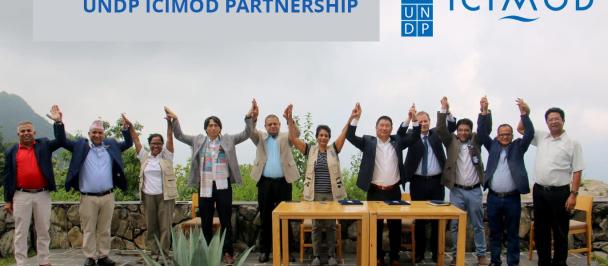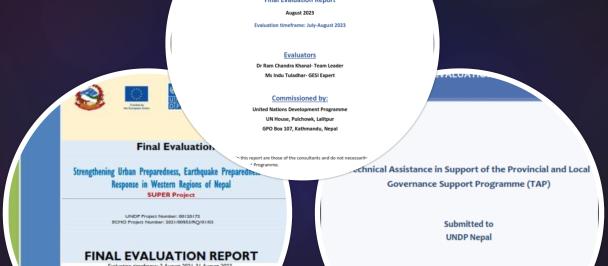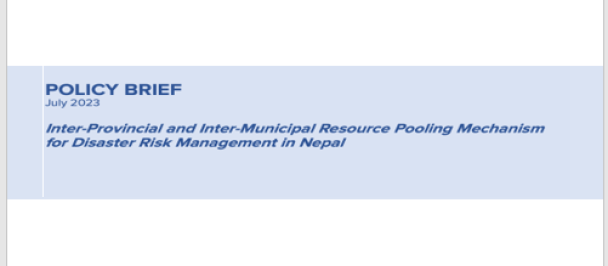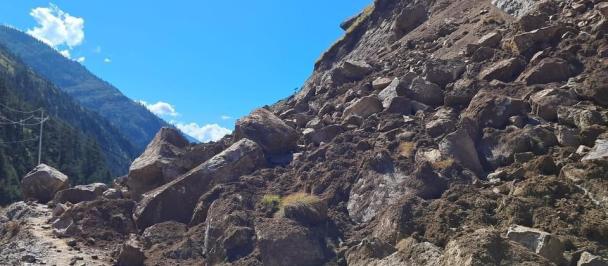Comprehensive Disaster Risk Management Programme
Comprehensive Disaster Risk Management Programme (CDRMP)
| Status: | Active | ||
| Duration: | February 2011 - December 2018 | ||
| Geographic coverage: | Policy level project at central government level; active in 54 districts (Terai: 19 districts, Hills: 27 districts, Mountains: 8 districts) | ||
| Focus area: | Energy, Environment, Climate and Disaster Risk Management | ||
| Collaborating institutions: | Ministry of Home Affairs (MoHA) (Lead), Ministry of Federal Affairs and Local Development (MoFALD), Ministry of Urban Development (MoUD), National Planning Commission (NPC), Ministry of Science and Technology (MoST), Ministry of Population and Environment (MoPE), Ministry of Forests and Soil Conservation (MOFSc), Ministry of Agriculture Development (MoAD), Kathmandu Valley Development Authority (KVDA), Nepal Administrative Staff College (NASC), Local Development Training Academy (LDTA), Tribhuvan University-Central Department of Environmental Science (TU-CDES), Council for Technical Education and Vocational Training (CTEVT) | ||
| Donors: | DFID, Republic of Korea, ECHO, World Bank, Japan, UNDP |
Summary
UNDP has been implementing the Comprehensive Disaster Risk Management Programme (CDRMP) since 2011 as part of the Strategic Partnership Framework (SPF), signed between the Geneva-based Bureau for Crisis Prevention and Recovery (UNDP/BCPR) and UNDP Nepal and in accordance with the Nepal Risk Reduction Consortium. The programme aims to strengthen the institutional and legislative aspects of disaster risk management (DRM) in Nepal by building the capacities of the Ministry of Home Affaris (MoHA), the Ministry of Federal Affairs and Local Development (MoFALD), National Planning Commission (NPC), other partner ministries, departments and local governments as well as empowering vulnerable communities toward increased resilience.
Objectives
CDRMP has been contributing to achieving the national goal of making the country disaster resilient. Its objectives have been aligned in line with UNDP's overall outcome and outputs which have been set jointly by UNDP Nepal and the Government of Nepal. It contributes to the UNDP Strategic Plan Outcome -"Countries are able to reduce the likelihood of conflict and lower the risk of natural disasters, including from climate change". The programme also contributes towards achieving Nepal’s United Nations Development Assistance Framework (UNDAF, 2013-2017) Outcome 7, which states: people living in areas vulnerable to climate change and disasters benefit from improved risk management and are more resilient to hazard-related shocks.
Read more about how the project contributes to the UN Development Assistance Framework
What have we accomplished so far?
Institutional & Legislative System
The strengthening or establishment of ILS involves preparation and formalization of policy frameworks, the creation of national structures for DRM, the preparation of national plans and other planning instruments, the review and revision of existing legal and regulatory frameworks or the development of new legislation and the creation of national capacity building, resources and management support programmes and partnerships (international and national levels).
Strategic Linkages with the other Sectors (Mainstreaming)
Nepal is a country with high disaster risk and low disaster risk management capacities. Recurrent disasters, particularly at the local level, are compromising the achievement of the Millennium Development Goals (MDGs). While there is clearly a need to strengthen capacities of focal institutions dealing with the consequences of disasters, in order to achieve sustainable reduction in disaster risk, it is equally important to integrate disaster risk reduction concerns in the workings of key development sectors that are exposed to natural disasters. The NSDRM fully recognizes this and has accordingly made provisions for mainstreaming disaster risk reduction in nine (9) different sectors. This programme area will aim to advance this aspect of the NSDRM.
Nepal National Building Code and Risk Sensitive Land Use Planning
Although the National Building Code (NBC) came into existence in 1994, it was approved by the government Nepal only in 2003 through a decisionof the Cabinet. The Bureau of Standards and Metrology has initiated a process for defining the draft Building Code as a Nepal Standard. Several of the 22 documents prepared for the National Building Code, which focuses on seismic safety, were accepted as Nepal Standards.
Climate Risk Management
Nepal has recently finalized its National Adaptation Programme of Action (NAPA), which has identified urgent and immediate adaptation needs and priority actions in 6 sectors: Agriculture and Food Security; Forests and Biodiversity; Water and Energy; Urban Settlements and Infrastructure; Public Health; and Climate-induced Disasters. This programme area will contribute to addressing the risk of climate related disasters.
Community Based Disaster Risk Management
UNDP would like to play a more strategic role in supporting CBDRM projects. Instead of implementing the projects at the community level, the programme will build the capacity of NGOs and CSOs for implementing the CBDRM. It will develop benchmarks against which the effectiveness of CBDRM will be evaluated. The programme will organize training programs for NGOs and CSOs, hold workshops for sharing of experiences, and bring local government and implementing partners together for greater synergy.
Emergency Preparedness and Response
Emergency preparedness and response is a flagship area of the Nepal Disaster Risk Reduction Consortium led by Office for the Coordination of Humanitarian Affairs (OCHA), and the priority outcomes include strengthening disaster information and response management, capacity building of first responders, building a network of emergency warehouses and mobilization centres across Nepal, and strengthening legal mechanisms for the facilitation and regulation of international assistance.
Working closely with OCHA, UNDP will support the flagship area through a number of activities. It has already supported setting up of the National Emergency Operations Center, and participated in a number of workshops for contingency planning at the district level. Building on its earlier interventions, UNDP will implement the programme in partnership with the Ministry of Home Affairs, district administration, municipalities, and NGOs.
Early Recovery
UNDP has been designated as the cluster lead for early recovery at the global level. In Nepal too, UNDP has played the role of a lead agency in advocating and supporting early recovery, particularly after the Koshi floods. UNDP provided support to the government by coordinating early recovery with other UN agencies and NGOs which are the members of Inter-Agency Standing Committee (IASC).
UNDP Nepal with the assistance of BCPR has planned and supported several post-conflict interventions which are in nature of early recovery. These interventions are in the areas of livelihoods, peace-building, reintegration, etc. Further, Koshi floods have provided several lessons for improving the practice of early recovery. One of the important lessons is to develop greater awareness of the concept of early recovery and its tools and interventions. The programme will bring new concepts, skills, and resources to support early recovery.
Read more about CDRMP's accomplishments
Documents
CDRMP Annual Progress Report 2016
Publications
Seismic Retrofitting Guidelines of Buildings in Nepal: Compilation of Adobe, Masonry and RCC
Lessons and Learning from 2015 Earthquake Response
Tips on Assessing and Restoring/Demolishing Earthquake-Affected Structures
Contacts
UNDP focal point:
Vijaya P. Singh
Assistant Country Director, UNDP
Pulchowk,Lalitpur
PO Box 107
Tel: (+977-1) 5523200 Ext. 1028
Email: vijaya.singh@undp.org
Email: cdrmp.np@undp.org
Website: www.np.undp.org/cdrmp

 Locations
Locations













